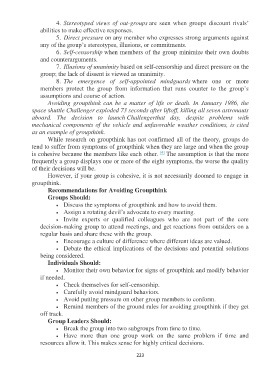Page 223 - 6484
P. 223
4. Stereotyped views of out-groups are seen when groups discount rivals’
abilities to make effective responses.
5. Direct pressure on any member who expresses strong arguments against
any of the group’s stereotypes, illusions, or commitments.
6. Self-censorship when members of the group minimize their own doubts
and counterarguments.
7. Illusions of unanimity based on self-censorship and direct pressure on the
group; the lack of dissent is viewed as unanimity.
8. The emergence of self-appointed mindguards where one or more
members protect the group from information that runs counter to the group’s
assumptions and course of action.
Avoiding groupthink can be a matter of life or death. In January 1986, the
space shuttle Challenger exploded 73 seconds after liftoff, killing all seven astronauts
aboard. The decision to launch Challengerthat day, despite problems with
mechanical components of the vehicle and unfavorable weather conditions, is cited
as an example of groupthink.
While research on groupthink has not confirmed all of the theory, groups do
tend to suffer from symptoms of groupthink when they are large and when the group
[4]
is cohesive because the members like each other. The assumption is that the more
frequently a group displays one or more of the eight symptoms, the worse the quality
of their decisions will be.
However, if your group is cohesive, it is not necessarily doomed to engage in
groupthink.
Recommendations for Avoiding Groupthink
Groups Should:
• Discuss the symptoms of groupthink and how to avoid them.
• Assign a rotating devil’s advocate to every meeting.
• Invite experts or qualified colleagues who are not part of the core
decision-making group to attend meetings, and get reactions from outsiders on a
regular basis and share these with the group.
• Encourage a culture of difference where different ideas are valued.
• Debate the ethical implications of the decisions and potential solutions
being considered.
Individuals Should:
• Monitor their own behavior for signs of groupthink and modify behavior
if needed.
• Check themselves for self-censorship.
• Carefully avoid mindguard behaviors.
• Avoid putting pressure on other group members to conform.
• Remind members of the ground rules for avoiding groupthink if they get
off track.
Group Leaders Should:
• Break the group into two subgroups from time to time.
• Have more than one group work on the same problem if time and
resources allow it. This makes sense for highly critical decisions.
223

